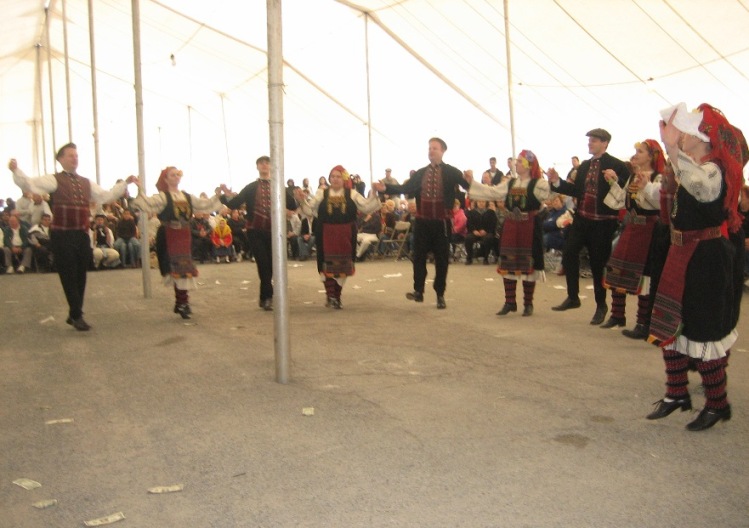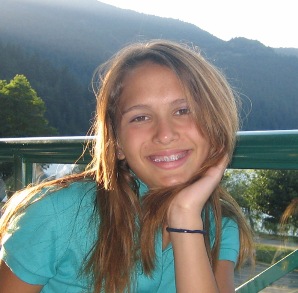Orpheus Hellenic Folklore Society Newsletter
| Tarpon
Springs Marks Centennial Epiphany Celebration Click here for more pictures... |
This year marked the 100th year anniversary of St. Nicholas Greek
Orthodox Church in Tarpon Springs, Florida. It also marked the centennial
anniversary of the Epiphany ceremony which now takes place at Spring Bayou.
Local teenage boys, ages 16-18, dive for the honor of retrieving the fallen
cross in its waters.  His
All Holiness Ecumenical Patriarch Bartholomew was present for this historic
occasion and presided over many of the ceremonies and events that took place
that weekend. Accompanying him were His Eminence Archbishop of America
Demetrios and all the Metropolitans from the United States, including His
Eminence Metropolitan Iakovos of Chicago and His Eminence Metropolitan
Nikitas of Hong Kong, who is a native of Tarpon Springs. Metropolitan
Nikitas is also the brother of John Lulias, the chairman of the annual
Winter Dance Conference, which took place in Tarpon Springs during the same
period. His
All Holiness Ecumenical Patriarch Bartholomew was present for this historic
occasion and presided over many of the ceremonies and events that took place
that weekend. Accompanying him were His Eminence Archbishop of America
Demetrios and all the Metropolitans from the United States, including His
Eminence Metropolitan Iakovos of Chicago and His Eminence Metropolitan
Nikitas of Hong Kong, who is a native of Tarpon Springs. Metropolitan
Nikitas is also the brother of John Lulias, the chairman of the annual
Winter Dance Conference, which took place in Tarpon Springs during the same
period.  The
Winter Dance Conference includes a series of workshops on Greek folk
traditions in the areas of dance, music and costumes. The workshops are
conducted by renowned instructors from Greece, the U.S. and Canada. This
year, registration reached capacity as over 250 participants visited this
historic Greek community. Conference members, apart from attending all day
workshops and enjoying folk music and dance during the evening events,
participated in many activities surrounding the Epiphany centennial
celebrations. Among the participating groups was the Orpheus Dance Troupe of
Chicago. On Epiphany day, dance groups, dressed in folk costumes, marched
down the streets of Tarpon Springs along with marching bands and other
groups. They all converged at Spring Bayou, where the official ceremony took
place. The
Winter Dance Conference includes a series of workshops on Greek folk
traditions in the areas of dance, music and costumes. The workshops are
conducted by renowned instructors from Greece, the U.S. and Canada. This
year, registration reached capacity as over 250 participants visited this
historic Greek community. Conference members, apart from attending all day
workshops and enjoying folk music and dance during the evening events,
participated in many activities surrounding the Epiphany centennial
celebrations. Among the participating groups was the Orpheus Dance Troupe of
Chicago. On Epiphany day, dance groups, dressed in folk costumes, marched
down the streets of Tarpon Springs along with marching bands and other
groups. They all converged at Spring Bayou, where the official ceremony took
place.  At
the conclusion of the ceremony, the dance groups performed Greek folk dances
for all the guests at the Sponge Docks in Tarpon Springs. The tradition of
sponge diving was brought to this area by early 20th century Greek
immigrants who were primarily from the island of Kalymnos, where they were
known for their sponge diving trade. At
the conclusion of the ceremony, the dance groups performed Greek folk dances
for all the guests at the Sponge Docks in Tarpon Springs. The tradition of
sponge diving was brought to this area by early 20th century Greek
immigrants who were primarily from the island of Kalymnos, where they were
known for their sponge diving trade.  The
day following the Epiphany ceremony, international recording star Mario
Frangoulis gave a concert honoring His All Holiness Bartholomew. Mario
Frangoulis remarked that it was an honor to perform for the Ecumenical
Patriarch because he is a symbol of love to our community. The concert also
benefited St. Nicholas Orthodox Parochial School in Tarpon Springs. The
event took place at the Sun Bowl arena of the University of South Florida in
Tampa, Florida. It featured the Orlando Philharmonic Orchestra under the
direction of Andrew Lane, soprano Deborah Meyers, the Archdiocesan
Metropolitan Youth Choir under the direction of Maria Koleva and the dancers
from the Winter Dance Conference. The dancers performed Zorba the Greek and
a typical Syrto dance, dressed in full costume attire, adding a special
flavor to the concert. The
day following the Epiphany ceremony, international recording star Mario
Frangoulis gave a concert honoring His All Holiness Bartholomew. Mario
Frangoulis remarked that it was an honor to perform for the Ecumenical
Patriarch because he is a symbol of love to our community. The concert also
benefited St. Nicholas Orthodox Parochial School in Tarpon Springs. The
event took place at the Sun Bowl arena of the University of South Florida in
Tampa, Florida. It featured the Orlando Philharmonic Orchestra under the
direction of Andrew Lane, soprano Deborah Meyers, the Archdiocesan
Metropolitan Youth Choir under the direction of Maria Koleva and the dancers
from the Winter Dance Conference. The dancers performed Zorba the Greek and
a typical Syrto dance, dressed in full costume attire, adding a special
flavor to the concert.For additional pictures from the Epiphany and Winter Dance Conference events click here. |
|
|
|
Orpheus
Benefit a Big Success! Click here for more pictures, video clips, program book |
 On
Saturday November 6th the Chateau Ritz Banquet Hall was filled to
capacity as close to 700 guests were present at the Benefit organized by the
Orpheus Hellenic Folklore Society. The evening included music, dance and
choral presentations by the Orpheus Youth and Adult dance groups as well as
the Orpheus Music Group. A silent auction complimented the activities as
guests browsed through a wide variety of gifts. A special program book was
issued for that night, which included highlights of the history of the
Orpheus Dance Troupe over the last 17 years, as well as announcements and
greetings from businesses and individual donors. On
Saturday November 6th the Chateau Ritz Banquet Hall was filled to
capacity as close to 700 guests were present at the Benefit organized by the
Orpheus Hellenic Folklore Society. The evening included music, dance and
choral presentations by the Orpheus Youth and Adult dance groups as well as
the Orpheus Music Group. A silent auction complimented the activities as
guests browsed through a wide variety of gifts. A special program book was
issued for that night, which included highlights of the history of the
Orpheus Dance Troupe over the last 17 years, as well as announcements and
greetings from businesses and individual donors.
|
| Spotlight on Orpheus Youth Dancer... |
Christina Grosso |
| Hometown: |
Chicago, IL. |
| Parents/Family From: |
My mom’s family is from Messinia, Greece, Yiayia is from Lahanatha (near Methoni), and Pappou is from Starasa (outside of Koroni). My dad is from Chicago, but my grandfather is from outside of Bari, Italy. |
| Time Dancing with Orpheus Group: |
|
| Thoughts on Dancing: |
|
| Favorite Dance: |
My favorite dance is Baidouska because it is a very high energy dance. I also love learning new dances of any kind. |
| Most Vivid OHFS Memory: |
Boca Raton Winter Dance Conference, hanging out at the pool. I loved dancing and singing in the water. I also loved walking around the sponge docks and dancing in Tarpon Springs with Mario Frangoulis. |
| Favorite Greek Dish: |
|
| Favorite Place in Greece: |
The beaches in Finikouda, Messinia. I can walk around and everyone knows me. I get a lot of free ice-cream! |
| Hobbies/Sports/Other Interests: |
Dancing, shopping, Greek drama, soccer (I play defensive midfielder.), music (I have been playing the violin since I was 4.) and singing in both Greek and English. |
| Best Childhood Memory: |
I love going to my yiayia and pappou’s cottage and hanging out with my cousins. |
| Dream vacation/the perfect weekend: |
I would like to go to Italy to find my dad’s family. |
| Favorite building/spot in Chicago: |
|
| I'm currently looking for/forward to: |
|
| I stay home to watch: |
The OC. |
| Prized possession: |
My family and friends. |
| Where I heard about Orpheus Dance Troupe: |
It has always been there for me!!!! |
Last revised:
01/06/2013 12:40 PM